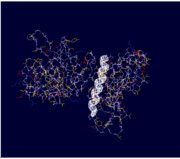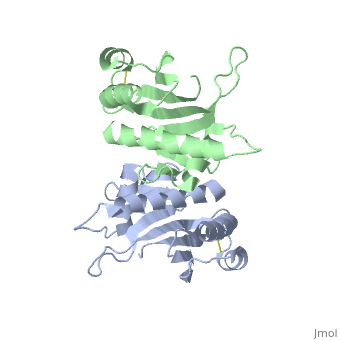Introduction
Pilin (PIL) or fimbrial protein is a fibrous protein found in the pilus of bacteria. Pili in bacteria are used for exchange of DNA during bacterial conjugation. Type IV pili play an important role in the pathogenesis of many bacterial species; they are a required component for the adhesion of bacteria to their target cells. For example, Type IV pili are required for infection by the pathogens that cause cholera, typhoid, pneumonia, gonorrhea, and meningitis. [1] They may also mediate transformation, modulate target-cell specificity and play a role in twitching motility. PilS is a protein that is a member of the pilin protein superfamily. [2]
Structure
Type IV pilin are homopolymers, composed of a single-chain pilin protein called major pilin and a less abundant protein called minor pilin which are essential for the pilus assembly and function[1]. The first common element that all type IVb pilins contain is the inclusion of the C-terminal β-strand (β7 in PilS) in the center of the structure, forming an antiparallel arrangement. [1] A conserved 25 residue hydrophobic N terminal sequence, that serves as an oligomerization domain for fibre formation, is shared by all type IV pilins. Finally, all pilins also share a conserved pilus assembly machinery, a unique N-methylated N-terminus and a pair of conserved cysteines that form an intrachain disulphide bond. The type IVb pilus operon of S. typhi contains the piLS gene, which encodes a structural pilin. [1]
The cysteine-containing region in the C-terminus is thought to play a function via the formation of disulfides in CFTR adhesion and in the assembly of PilS to make the pilus of the bacterium. The highly conserved N-terminal hydrophobic tail functions as a oligomerization domain for fibre formation. [2] The D-region of the type IVb pilins is known to contain residues that function in pilus assembly; this region is stabilized by a conserved disulfide bond. [1]

Highly Conserved N-Terminal Helix of the Type IVb Pilin
192 water molecules and 2107 non-hydrogen atoms are found in the native structure of PilS and the loop regions of this protein are highly flexible. The crystal structure of PilS contains the standard αβ fold of the type IVb pilin, with a central anti-parallel β-sheet platform that is made up of seven β strands, and surrounded by four α helices. The complete β sheet topology of PilS is β1-β2-β3-β4-β7-β5-β6. [1] The N-terminal alpha helix (α1) can be found on three of these strands (β3, β4, and β7).The alpha helix of the type IVb pilins is straight, as there is no proline or glycine present in positions that would disturb the structure of the helix. The region between the N-terminal alpha helix and β3 (the αβ-loop) contains another alpha helix (α2) and also a pair of anti-parallel β-strands (β1 and β2). Helix α2 packs almost perpendicular to and on top of helix α1, causing helix α2, strand β1, and the α1-α2 loop of PilS to be all located on one side of the molecule. Finally, a disulfide bridge links the residues Cys126 and Cys 163. [1]
The final model of the PilS complex structure consists of a dimer of 149 amino acid residues of each monomer and the 10-mer peptide and 262 water molecules. The movement of two lysine side chains in the complex structure function to bind the peptide by making ionic contacts (formation of salt bridges) with the negatively charged residues of the CFTR peptide.[1]
Function
Type IV pili are diverse in function; they mediate numerous cellular functions via their polymeric machinery. These functions include cell adhesion, signalling, phage attachment, surface motility, biofilm formation and DNA uptake by natural transformation. Specifically, the type IVb pilus of Salmonella typhi is the adhesion factor that allows the pathogen to enter into the gastrointestinal cells of humans with ease. The first step in S.typhi pathogenesis is the type IVb pilus self-mediated self-association in the anerobic human small intestine preceding the entry into the human intestine epithelium. [1]
A proposed prerequisite for CFTR binding is the dimer formed in the symmetrical subunit of PilS. [2] The type IVb PilS protein binds to a 15-mer peptide that corresponds to the first extracellular domain of the human cystic fibrosis transmembrane regulator (an epithelial chloride channel) in the INT407 cell membrane. PilS contains a binding pocket in the region where the CFTR peptide is attached to the protein. [1] The surface around this active site pocket is slightly positively charged because of the presence of Lys75, Lys120, and Arg 169. This means it is able to effectively bind the negatively charged CFTR peptide. Residues 113-117 of CFTR are crucial for the S. typhi pilus binding and Glu115 and Glu116 of the peptide are involved in binding to the PilS protein.[1]
PilS causes typhoid by entering the enterocytes and specialized M cells of the small intestine. After entry, it is transferred to the intestinal submucosa and is taken up by host macrophages. The overall mechanism of the entry into the enterocytes is complicated and involves intercellular adhesins and intracellular signaling which change the host cell's vacuolar and cytoskeletal organization. [1]
3D Structures of pilin
Pilin 3D structures


